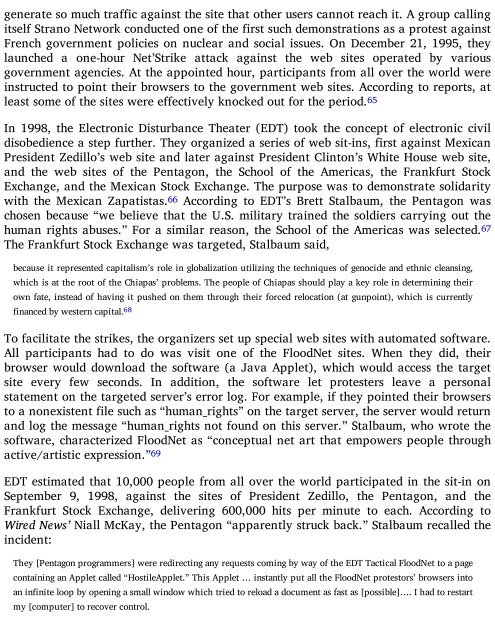RAND_MR1382
You also want an ePaper? Increase the reach of your titles
YUMPU automatically turns print PDFs into web optimized ePapers that Google loves.
generate so much traffic against the site that other users cannot reach it. A group calling<br />
itself Strano Network conducted one of the first such demonstrations as a protest against<br />
French government policies on nuclear and social issues. On December 21, 1995, they<br />
launched a one-hour Net’Strike attack against the web sites operated by various<br />
government agencies. At the appointed hour, participants from all over the world were<br />
instructed to point their browsers to the government web sites. According to reports, at<br />
least some of the sites were effectively knocked out for the period. 65<br />
In 1998, the Electronic Disturbance Theater (EDT) took the concept of electronic civil<br />
disobedience a step further. They organized a series of web sit-ins, first against Mexican<br />
President Zedillo’s web site and later against President Clinton’s White House web site,<br />
and the web sites of the Pentagon, the School of the Americas, the Frankfurt Stock<br />
Exchange, and the Mexican Stock Exchange. The purpose was to demonstrate solidarity<br />
with the Mexican Zapatistas. 66 According to EDT’s Brett Stalbaum, the Pentagon was<br />
chosen because “we believe that the U.S. military trained the soldiers carrying out the<br />
human rights abuses.” For a similar reason, the School of the Americas was selected. 67<br />
The Frankfurt Stock Exchange was targeted, Stalbaum said,<br />
because it represented capitalism’s role in globalization utilizing the techniques of genocide and ethnic cleansing,<br />
which is at the root of the Chiapas’ problems. The people of Chiapas should play a key role in determining their<br />
own fate, instead of having it pushed on them through their forced relocation (at gunpoint), which is currently<br />
financed by western capital. 68<br />
To facilitate the strikes, the organizers set up special web sites with automated software.<br />
All participants had to do was visit one of the FloodNet sites. When they did, their<br />
browser would download the software (a Java Applet), which would access the target<br />
site every few seconds. In addition, the software let protesters leave a personal<br />
statement on the targeted server’s error log. For example, if they pointed their browsers<br />
to a nonexistent file such as “human_rights” on the target server, the server would return<br />
and log the message “human_rights not found on this server.” Stalbaum, who wrote the<br />
software, characterized FloodNet as “conceptual net art that empowers people through<br />
active/artistic expression.” 69<br />
EDT estimated that 10,000 people from all over the world participated in the sit-in on<br />
September 9, 1998, against the sites of President Zedillo, the Pentagon, and the<br />
Frankfurt Stock Exchange, delivering 600,000 hits per minute to each. According to<br />
Wired News’ Niall McKay, the Pentagon “apparently struck back.” Stalbaum recalled the<br />
incident:<br />
They [Pentagon programmers] were redirecting any requests coming by way of the EDT Tactical FloodNet to a page<br />
containing an Applet called “HostileApplet.” This Applet … instantly put all the FloodNet protestors’ browsers into<br />
an infinite loop by opening a small window which tried to reload a document as fast as [possible]…. I had to restart<br />
my [computer] to recover control.










![Genki - An Integrated Course in Elementary Japanese II [Second Edition] (2011), WITH PDF BOOKMARKS!](https://img.yumpu.com/58322134/1/180x260/genki-an-integrated-course-in-elementary-japanese-ii-second-edition-2011-with-pdf-bookmarks.jpg?quality=85)
![Genki - An Integrated Course in Elementary Japanese I [Second Edition] (2011), WITH PDF BOOKMARKS!](https://img.yumpu.com/58322120/1/182x260/genki-an-integrated-course-in-elementary-japanese-i-second-edition-2011-with-pdf-bookmarks.jpg?quality=85)





